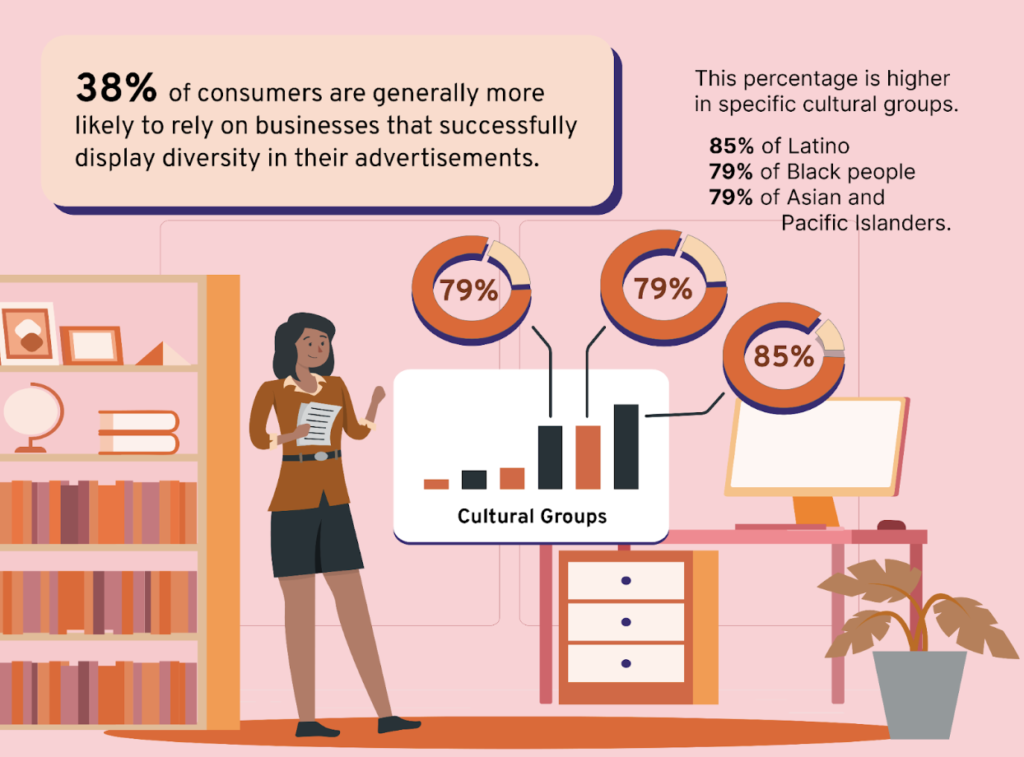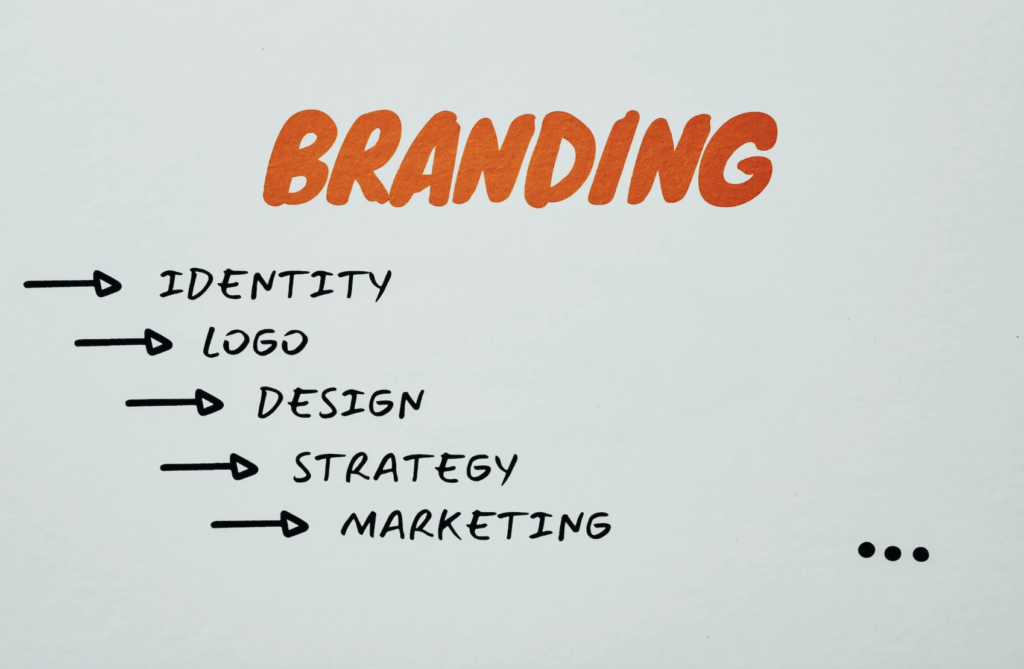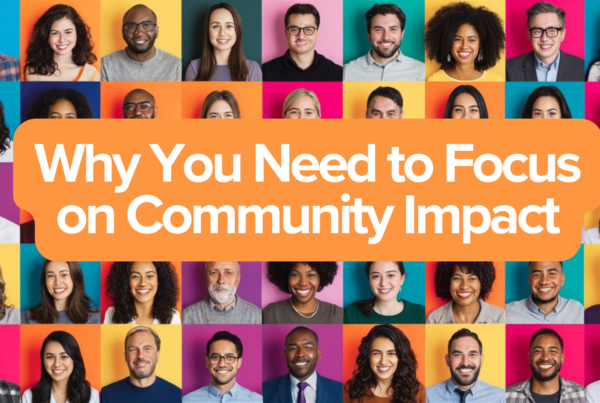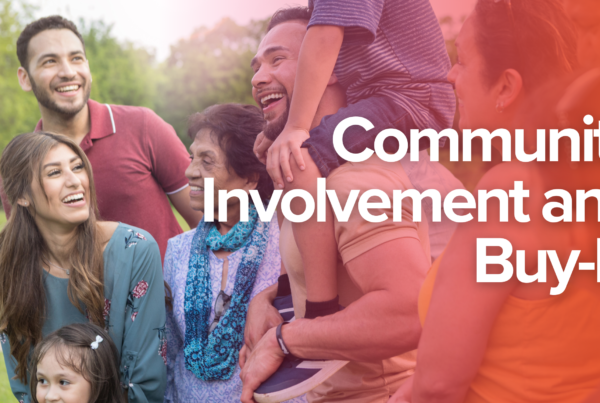In today’s world, any successful business should be able to reach customers trough proper channels. To do this, businesses must understand all the nuances and ins and outs of multicultural marketing. What is multicultural marketing? How does it work? In order to use multicultural marketing to its full potential, you will need to get a better understanding of it and learn how to incorporate it to help your business grow and stay relevant.

What is Multicultural Marketing?
Multicultural marketing or diversity marketing includes targeting products or services specifically to different cultural and ethnic groups. Essentially, it’s an approach to advertising that takes into account the cultural differences among various ethnic groups. The goal is to connect with consumers in a way that is authentic and meaningful, while also building trust and loyalty with these communities. Even though it seems like a new concept, it allows businesses to target their message specifically towards certain demographics (African Americans, Hispanics, Asian Americans, Native Americans, or other cultures) that may be more likely to purchase their product or service.
This type of advertising approach allows businesses to target niche markets in order to increase sales and profits. However, the main goal is to connect with potential customers on a deeper level by creating messages that are relevant and meaningful to them.
What Does Multicultural Marketing Involve?
Inclusive marketing involves more than just changing up a company’s products or services for different cultures – it involves understanding the culture itself, its values, interests, language, and communication styles. This can involve researching different cultures, as well as getting feedback from people within those cultures about how best to market to them. Companies may also need to adjust their branding strategy in order to appeal to diverse audiences. This could involve adjusting messaging or visuals so that they are more inclusive or culturally relevant. For example, if a company is targeting Hispanic consumers in the US, it may want to incorporate Spanish into its messaging or use visuals featuring Hispanic models.
Why Does Multicultural Marketing Matter?
As our society continues to become more diverse, multicultural marketing will become even more important for businesses looking to stay competitive in today’s market. By using this strategy, businesses can do the following:
- It can enable tapping into new markets. It does so by connecting companies with people who may have been previously overlooked or underserved by traditional advertising strategies.
- It can help build genuine trust between consumers and brands by showing them that their culture is valued and respected.
- It can be used as an effective tool for increasing brand loyalty.
Finally, it helps brands gain insight into potential audiences that could benefit from products or services offered by the business.

Benefits of Multicultural Marketing
There are several benefits associated with implementing a successful multicultural marketing strategy. Iit allows your company to reach new markets that wouldn’t have been accessible before – especially those with different cultures and languages from yours. Additionally, businesses get access to potential customers who may not have been exposed to traditional forms of advertising but may still be interested in your product or service, and therefore more likely to buy it. Finally, multicultural marketing helps create brand loyalty by allowing companies to develop relationships with different communities over time.
Promotes Brand Reputation
Multicultural marketing also helps boost brand recognition for businesses by increasing their visibility within different cultural groups. When businesses create content tailored towards specific cultural groups, they become more recognizable within those communities, which can lead to greater brand awareness overall! Additionally, successful multicultural campaigns have been shown to increase customer satisfaction levels due to their personalization factor, and it ultimately leads to increased sales over time as well as greater customer loyalty down the line.
Reaches A Wider Audience
This type of inclusive advertising technique also opens up new opportunities for brands by allowing them to reach out to markets that may not have been accessible before. By understanding the subtleties of different customer preferences, you can create campaigns that are tailored specifically for these groups. This will also allow access to new markets without having to spend extra money on expensive advertising campaigns or research efforts.
By leveraging an existing audience, companies can quickly establish themselves as trusted source in these new markets and start building relationships with potential customers who may not have been aware of their products or services beforehand. This in turn will lead to higher conversion rates and increased sales over time.
Helps Connect With Newer Generations
Another benefit of multicultural marketing is that it helps businesses create meaningful connections with diverse audiences. Having a deep understanding of different cultures can help businesses engage with customers on an emotional level and build strong relationships with them over time. Additionally, having a good grasp on different cultures can also help businesses avoid unintentionally offending customers from other countries or backgrounds by ensuring that their messages are culturally relevant and appropriate. This is especially important to the younger generations, and more specifically – to Gen Z. According to research done by Microsoft, 70% of Zoomers claim that they are more trusting of those brands that feature diversity in their advertising.
Improved Customer Relationships
When done correctly, inclusive marketing can help you build strong relationships with customers from all backgrounds. This type of marketing allows you to show potential customers that you understand their needs and wants in an authentic way. It also provides an opportunity to demonstrate how much value a business brings to their lives by providing relevant products or services for them.

Helps Change Mindsets
If you implement multicultural marketing into your business in a genuine way, you can help change mindsets. It’s possible by promoting diversity, inclusivity, and understanding of different cultural groups. By creating campaigns and materials that are specifically tailored to the unique perspectives and experiences of different ethnic and racial groups, companies can help break down stereotypes and challenge negative perceptions.
Diversity advertising is more than just a technique that will drive your sales up. It can help show the diversity within a targeted market, which can help create a more nuanced understanding of different cultural groups. Challenging stereotypes and negative perceptions of different cultural groups show consumers that your brand is not only about profit, but that you genuinely care. By implementing this type of approach, you can help change the way people think about these groups. When providing information and resources that educate people about different cultural, ethnic, and religious backgrounds, companies can aid in dispelling myths and misconceptions.
Brands that practice showcasing diverse groups in advertising campaigns and materials can help promote a more accurate and positive representation of different cultures. And by creating narratives that highlight the shared experiences, struggles, and triumphs of different cultural groups can help foster empathy and understanding among people from different backgrounds.
Building Brand Loyalty
Successful inclusive marketing efforts can help build brand loyalty among consumers from different cultures or backgrounds. By showing that you understand and respect their culture’s values, you are sending the message that you care about them as individuals. Rather than just seeing them as customers who visit your website or store occasionally, you are connecting with them on a personal level. Building trust with these customers will lead them to become repeat visitors who purchase from your brand again and again, engage with your content and even share it with others. In the end, it leads to increased profits over time.

How Can I Use Multicultural Marketing The Right Way?
The key to successful multicultural marketing is understanding the cultural differences between various groups and being able to craft messaging that resonates with them. Additionally, you should make sure you are using platforms such as social media networks where members of these diverse groups are active in order for your message to reach its intended audience.
Research Your Audience
The first step in creating an effective multicultural marketing campaign is to research your target audience. Who are they? What do they care about? What languages do they speak? How do they prefer to receive information? Answering these questions will help you tailor your message to be more relevant and meaningful for the people you’re trying to reach.
Meet Your Audience and Examine Cultural Context
Do not jump right into it by making assumptions or stereotypes. You should research the culture, language, values, beliefs, behaviors, and customs of your target audience so you can create messages that will connect with them on an emotional level. Additionally, you should focus on creating content that appeals directly to their interests and needs. This might include using specific language or imagery related to their culture in your content or running campaigns focused on special occasions such as holidays or traditional events that are popular within the group you are targeting.
In the following video, you can hear a segment of a lecture on understanding cultural communication differences, led by Dr. Tom Verghese.
Develop an Understanding of Different Cultures
It’s important to have an understanding of different cultural, ethnic, and religious backgrounds when crafting effective inclusive campaigns. Make sure you deeply understand the beliefs, values, customs, and behaviors associated with each culture in order to create messages that resonate with those audiences. Additionally, it’s important to understand any cultural taboos or sensitivities so you don’t accidentally offend anyone with your message.
Avoid Cultural Appropriation
One of the mistakes you should avoid is using cultural symbols, imagery, or practices without permission or understanding their significance. When you start creating your campaigns and materials, you should always keep in mind that they should be tailored to the specific cultural group you are targeting and that they resonate with them. This will enable you to build a trustful connection and establish a more authentic relationship with your target audience.
Understand Cultural Awareness
It’s essential to have cultural awareness when engaging in minority advertising. This involves understanding different cultures, values, thought processes, and communication styles. It’s also important to understand why people behave the way they do in order to develop effective campaigns that resonate with them. Gaining an understanding of how people think will give you insight into how best to engage with them through your campaigns.
Create Multilingual Content
Creating content in multiple languages is key when it comes to reaching diverse audiences. If possible, try to produce content in the language your target audience speaks or understands best. This will help ensure that your message resonates with them more effectively. Additionally, if there are any cultural subtleties or differences between countries or regions that need to be taken into account when creating content for different languages, be sure to factor those into your strategy as well.
English has over 1,121 million speakers in the world, followed by Mandarin Chinese speakers (1,107,) and Hindi – 698 million.
Segmentation and Targeting
When developing multicultural campaigns, it’s important to consider who you are targeting. Segmentation plays a key role in this process by allowing you to segment your target market according to factors such as age, gender, language preferences, or interests. Understanding your target market will help you develop more targeted campaigns that speak directly to their needs and interests. This could involve creating content tailored for specific languages or creating targeted promotions for certain customer groups – whatever works best for your business!
Localization and Translation Services
Localization is another crucial factor when it comes to minority advertising. It involves adapting content and messaging so it resonates with different cultures or regions. Adapting your content can include using culturally appropriate images or translating the text into different languages (if applicable). If you don’t have the resources available in-house for translation services, there are many companies that can help with this process -just make sure they are experienced in providing high-quality translations that meet your standards!

Trends In Diversity Marketing
Companies around the world are beginning to recognize the importance of embracing diversity and inclusivity in their marketing campaigns. From global brands to local businesses, companies are recognizing that diversity advertising is no longer an afterthought – it’s a necessity. Let’s take a look at some of the emerging trends in this type of marketing strategy and how they can benefit your business.
Tailoring Messages to Different Audiences
Successful diversity marketing starts with understanding your target demographic and tailoring messages to fit their needs. This means more than just changing up the language you use; it means creating content that speaks authentically to each group. For example, if you’re targeting Hispanic consumers, you might consider creating content in Spanish as well as English. Or if you have a large Asian customer base, you may want to consider creating content in Chinese or Japanese. By doing so, you show that you understand and value your customers’ culture and language and that they are worth investing in – which goes a long way towards building loyalty.
Ethnic Influencers
Reaching out to ethnic influencers can be an effective strategy for reaching and connecting with specific cultural groups. Ethnic influencers are people who have a strong following and influence within a particular ethnic or cultural group. They can include popular musicians, actors, social media personalities, and community leaders.
Celebrating Cultural Heritage
Successful diversity marketing also requires celebrating cultural heritage rather than appropriating or tokenizing it for profit and making a big career mistake. This means using imagery, colors, symbols, and stories from different cultures without reducing them to stereotypes or oversimplifying them for mass consumption. For example, instead of simply featuring models of color wearing traditional clothing on your website or social media accounts, try highlighting stories from people within those cultures who have achieved success or made an impact on their community. Doing so will help create an authentic connection with potential customers who can relate to these stories on a personal level.
Promoting Inclusivity Through Your Brand Values
Finally, successful diversity advertising should be about more than just checking off boxes when it comes to representation – it should be about promoting inclusion through your brand values as well. This could mean anything from sponsoring events related to various cultures or causes to offering products specifically designed with minority groups in mind (such as plus size clothing lines). Whatever approach you choose, make sure that it reflects your company’s core values and resonates with the diverse customer base you are trying to reach.
You can see an example of inclusion in a great campaign done by Adidas in the following video.
Data-Driven Strategies
Today’s companies need to be able to use data to inform their decisions. This means creating strategies based on demographics, psychographics, geographics, and more. By understanding which consumer groups are responding positively to their product or service, you can customize the message and target those consumers effectively. Additionally, by looking at data collected from past campaigns, you can also assess what did and didn’t work with those campaigns and adjust their strategy accordingly.
Use Personalization as a Tool
Personalization has been an invaluable tool in the world of digital marketing for some time now. But this same tool can be used when it comes to diversity marketing as well. For example, companies should consider personalizing their messages so they appeal specifically to different cultural backgrounds or lifestyles. This could mean customizing web copy or emails for different audiences or even providing services tailored specifically for certain customer segments. The key here is understanding who your customers are and what they need from you as a business and then delivering that message in an effective way.
Inclusion and Representation
It’s not enough just to recognize diverse customer segments – businesses also need to find ways to include them in their messaging and represent them accurately within their products or services. Companies should strive to make sure all consumers feel included and valued regardless of race, gender identity, religion, or sexual orientation. This will help build trust with prospective customers who may have previously felt excluded from certain brands or products and services due to a lack of representation in advertising efforts. Additionally, businesses should make sure they are accurately representing different cultures in their campaigns rather than relying on stereotypes or inaccurate portrayals that could come across as offensive or out-of-touch with reality.
Focus on Authenticity
Finally, authenticity has become an increasingly important part of diversity marketing as well. People want to see brands being genuine with their messaging rather than simply trying to “sell” something or appear trendy for the sake of appearing trendy. Companies should make sure that their messaging reflects who they really are as a brand and how they truly feel about issues related to diversity and inclusion. This includes making sure their messaging isn’t tone-deaf or fake but instead shows empathy towards different communities while still providing value to those communities in meaningful ways.

Examples Of Multicultural Marketing Campaigns
Examples of Multicultural marketing campaigns can be both positive and negative. When done right, multicultural marketing can bring recognition, raise awareness and even create emotional connection with an inclusive brand. After all, 40% of the US population belongs to multicultural consumers. Lets see what we can learn from positive examples, and what not to do based on the biggest multicultural marketing fails.
Positive Examples of Multicultural Marketing Campaigns
When we are talking about positive multicultural marketing campaigns, those are mostly described as inspiring, and forming a lasting connection with the consumers. And here’s a fun fact: no less than 80% of Black Americans will flock to companies who openly show support to Black community and Black causes.
One good example of a marketing campaign done right is the Our Tone from Band-Aid, showcasing a Black ballerina Michaela DePrince. It resonates well with the audience because everybody knows how painful practicing can be, and even though people don’t think about it much, Black community certainly recognized the need for this product. It was something that should have been available all along.

Dove campaigns are usually on the dot, although they also had some unfortunate choices that backfired. But one of the latest positive examples from Dove is the hair discrimination that starts as early as when you are five. Thanks to their diverse campaigns, Dove has gained a status of a social warrior brand that fights for all the things that matter.
One of the most successful examples of multicultural marketing was Nike’s “Just Do It” campaign in 2018. The company highlighted how sports could bring people together regardless of their backgrounds, ages, or gender. This campaign successfully appealed to an international audience by featuring athletes from all over the world and speakers speaking in various languages.
Negative Multicultural Marketing Examples
On the other hand, there have been several negative examples of multinational companies attempting multicultural marketing campaigns that were met with criticism or failure. One example is Pepsi’s attempt at targeting millennials with its 2017 commercial featuring Kendall Jenner which some considered tone deaf and offensive to social justice causes such as Black Lives Matter.
As promised, here’s Dove again, but this time as an example of a poorly executed multicultural campaign. Dove’s 2017 “Real Beauty” ad campaign which many deemed racist for featuring a black woman turning into a white woman after using Dove soap instead of focusing on celebrating different skin tones as intended by the company.
These are just a few examples of multicultural marketing campaigns gone right – or wrong – that marketers should keep in mind when creating their own campaigns targeting diverse audiences. It is essential for companies to be aware of potential cultural sensitivities so they can create content that resonates with their audience without offending them or reinforcing harmful stereotypes. With careful consideration, marketers can put together engaging, meaningful campaigns that will help their businesses reach new heights!
But that’s why Multicultural Marketing Agencies like Phu Concepts exist, to help you and your brand navigate through tricky but very rewarding and diverse campaigns – but only when done by knowledgeable experts.
Create Effective Inclusive Campaigns to Reach Success
Multicultural marketing is an effective tool for expanding your customer base and reaching more potential customers than ever before. By understanding cultural awareness, segmentation, localization, and translation services, you will be able to create campaigns that resonate with diverse markets around the world. If done correctly, these efforts can result in increased brand recognition and higher sales from new customers. With the right strategy and execution plan in place, multicultural marketing can help take your business to new heights. Mastering the art of this type of advertising strategy is essential for success with audiences from all backgrounds.



